Vietnam National University: Yakult Vietnam Field Trip Report Analysis
VerifiedAdded on 2021/07/20
|13
|2736
|279
Report
AI Summary
This report is a comprehensive analysis of a field trip to the Yakult Vietnam factory, exploring its history, products, and market position. The report details the production process, including mixing, sterilization, fermentation, and packaging, while also examining quality control measures and supply chain management. It includes a SWOT analysis, evaluating the company's strengths, weaknesses, opportunities, and threats. The report also covers the composition of Yakult, its beneficial bacteria (Lactobacillus casei Shirota), and the company's mission and vision. Furthermore, the report highlights the company's adherence to strict hygiene standards and its use of advanced technology. The report provides a thorough evaluation of Yakult's operations, incorporating recommendations for future improvements and concluding with an overview of the company's contributions to health and business.
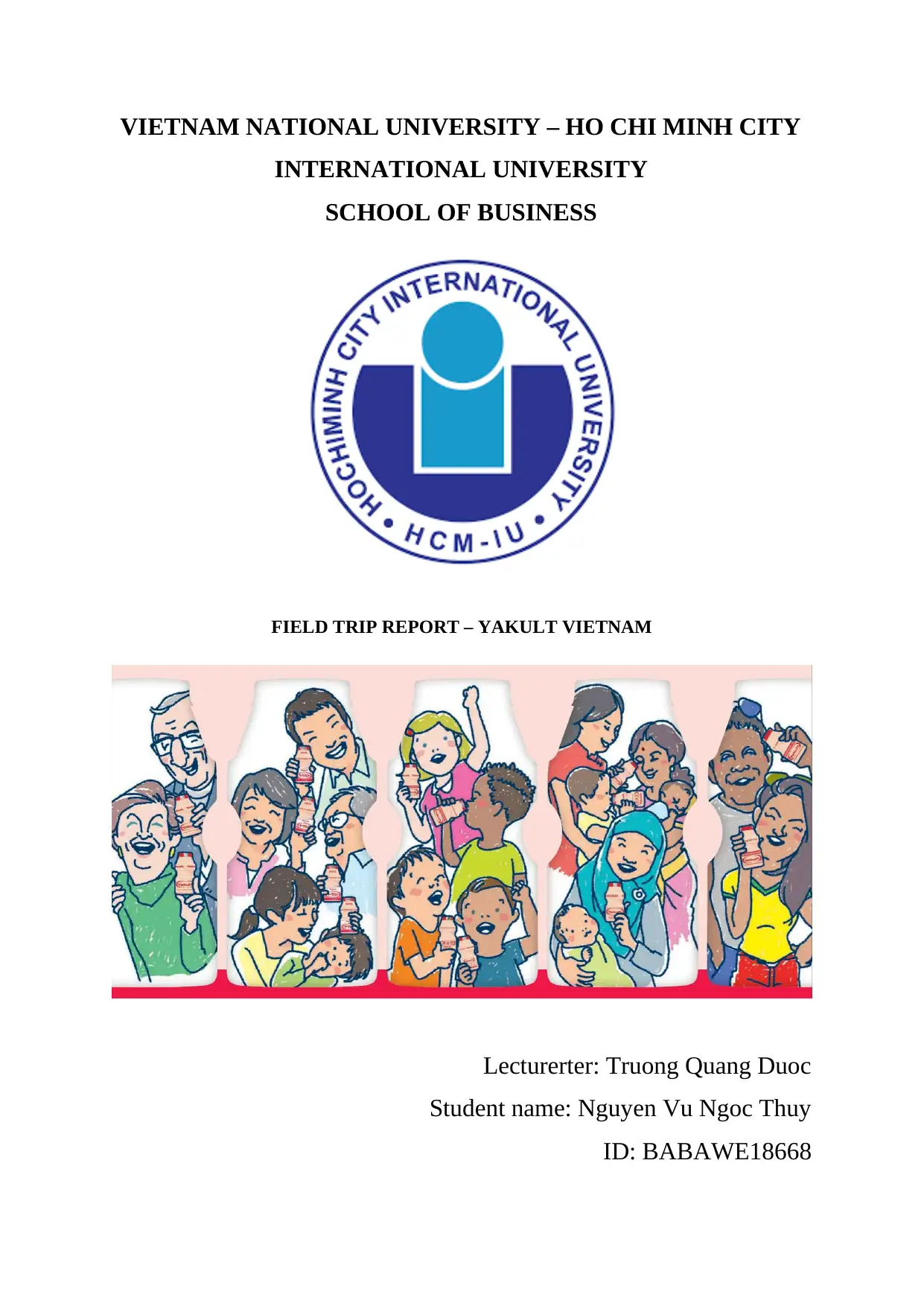
VIETNAM NATIONAL UNIVERSITY – HO CHI MINH CITY
INTERNATIONAL UNIVERSITY
SCHOOL OF BUSINESS
FIELD TRIP REPORT – YAKULT VIETNAM
Lecturerter: Truong Quang Duoc
Student name: Nguyen Vu Ngoc Thuy
ID: BABAWE18668
INTERNATIONAL UNIVERSITY
SCHOOL OF BUSINESS
FIELD TRIP REPORT – YAKULT VIETNAM
Lecturerter: Truong Quang Duoc
Student name: Nguyen Vu Ngoc Thuy
ID: BABAWE18668
Paraphrase This Document
Need a fresh take? Get an instant paraphrase of this document with our AI Paraphraser
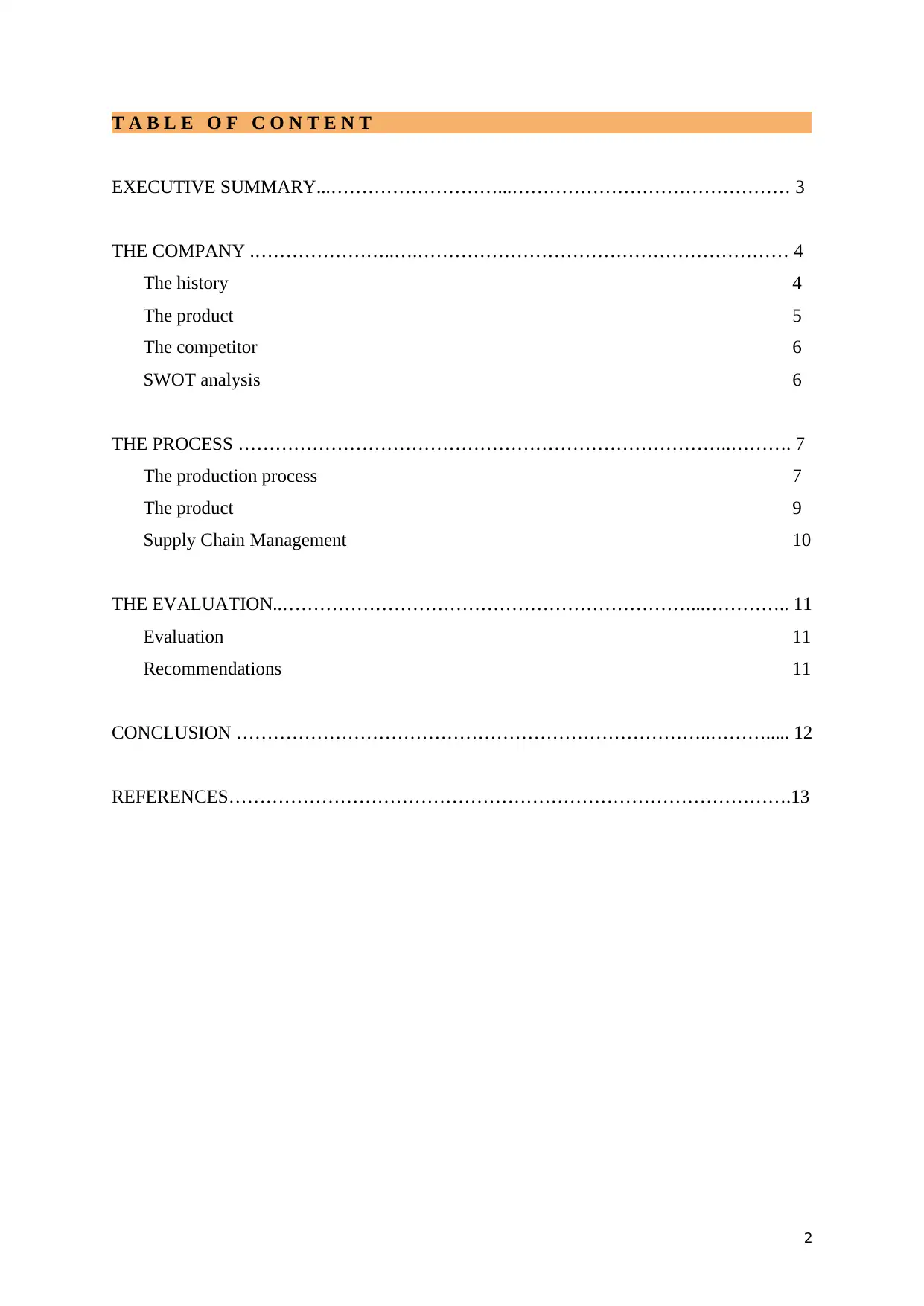
2
T A B L E O F C O N T E N T
EXECUTIVE SUMMARY...………………………...……………………………………… 3
THE COMPANY .…………………..….…………………………………………………… 4
The history 4
The product 5
The competitor 6
SWOT analysis 6
THE PROCESS ……………………………………………………………………..………. 7
The production process 7
The product 9
Supply Chain Management 10
THE EVALUATION..…………………………………………………………...………….. 11
Evaluation 11
Recommendations 11
CONCLUSION …………………………………………………………………..………..... 12
REFERENCES……………………………………………………………………………….13
T A B L E O F C O N T E N T
EXECUTIVE SUMMARY...………………………...……………………………………… 3
THE COMPANY .…………………..….…………………………………………………… 4
The history 4
The product 5
The competitor 6
SWOT analysis 6
THE PROCESS ……………………………………………………………………..………. 7
The production process 7
The product 9
Supply Chain Management 10
THE EVALUATION..…………………………………………………………...………….. 11
Evaluation 11
Recommendations 11
CONCLUSION …………………………………………………………………..………..... 12
REFERENCES……………………………………………………………………………….13
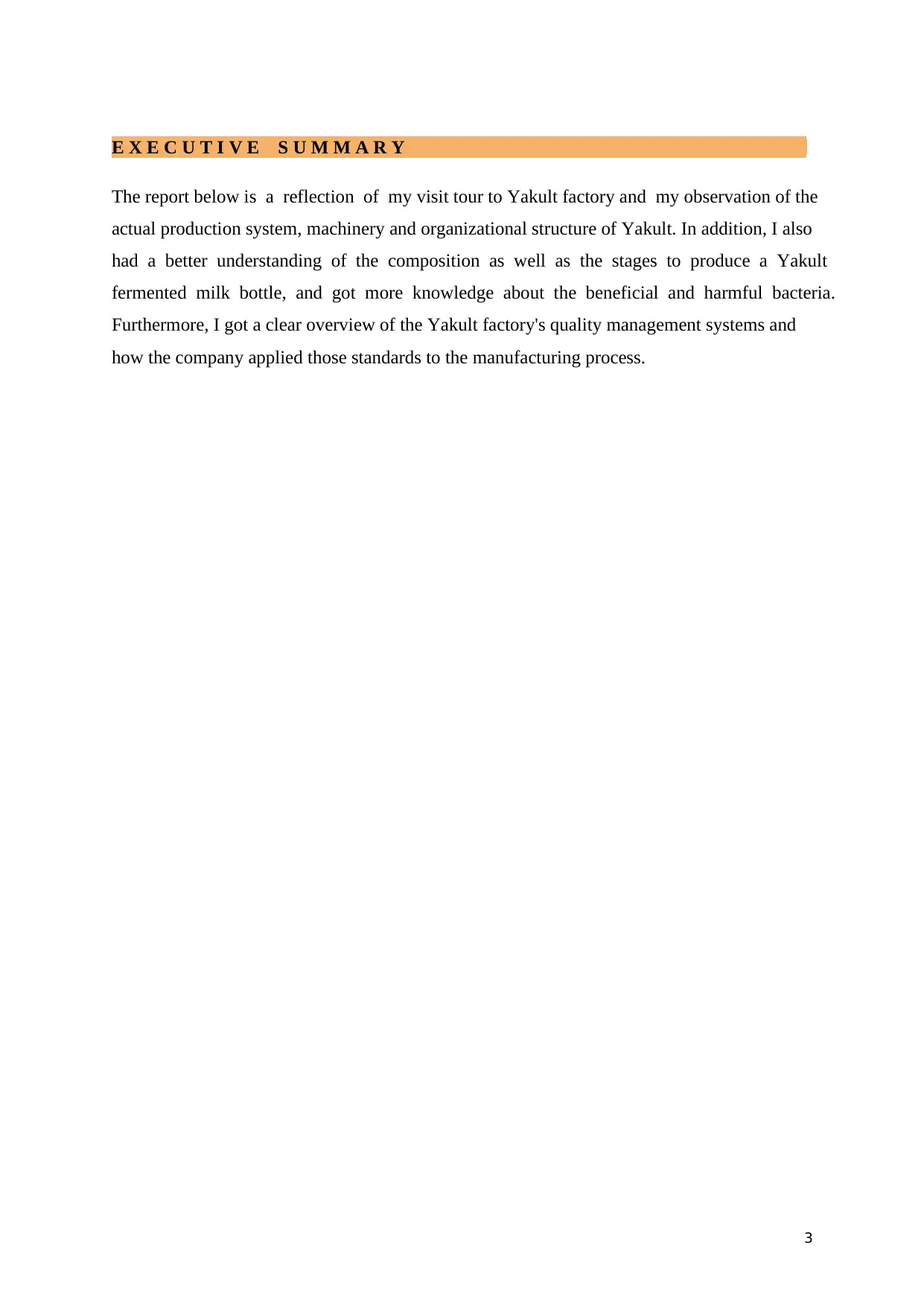
3
E X E C U T I V E S U M M A R Y
The report below is a reflection of my visit tour to Yakult factory and my observation of the
actual production system, machinery and organizational structure of Yakult. In addition, I also
had a better understanding of the composition as well as the stages to produce a Yakult
fermented milk bottle, and got more knowledge about the beneficial and harmful bacteria.
Furthermore, I got a clear overview of the Yakult factory's quality management systems and
how the company applied those standards to the manufacturing process.
E X E C U T I V E S U M M A R Y
The report below is a reflection of my visit tour to Yakult factory and my observation of the
actual production system, machinery and organizational structure of Yakult. In addition, I also
had a better understanding of the composition as well as the stages to produce a Yakult
fermented milk bottle, and got more knowledge about the beneficial and harmful bacteria.
Furthermore, I got a clear overview of the Yakult factory's quality management systems and
how the company applied those standards to the manufacturing process.
⊘ This is a preview!⊘
Do you want full access?
Subscribe today to unlock all pages.

Trusted by 1+ million students worldwide
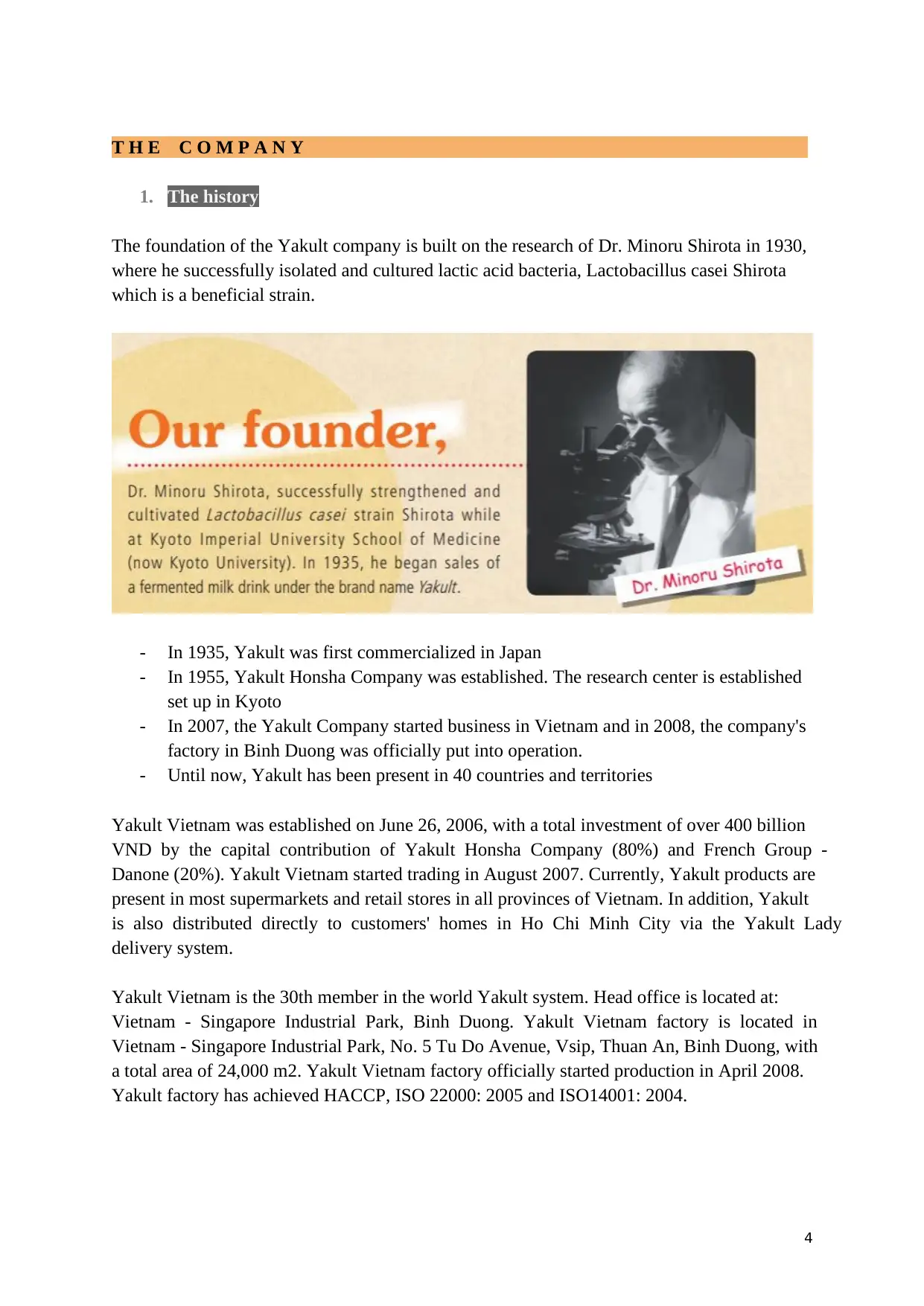
4
T H E C O M P A N Y
1. The history
The foundation of the Yakult company is built on the research of Dr. Minoru Shirota in 1930,
where he successfully isolated and cultured lactic acid bacteria, Lactobacillus casei Shirota
which is a beneficial strain.
- In 1935, Yakult was first commercialized in Japan
- In 1955, Yakult Honsha Company was established. The research center is established
set up in Kyoto
- In 2007, the Yakult Company started business in Vietnam and in 2008, the company's
factory in Binh Duong was officially put into operation.
- Until now, Yakult has been present in 40 countries and territories
Yakult Vietnam was established on June 26, 2006, with a total investment of over 400 billion
VND by the capital contribution of Yakult Honsha Company (80%) and French Group -
Danone (20%). Yakult Vietnam started trading in August 2007. Currently, Yakult products are
present in most supermarkets and retail stores in all provinces of Vietnam. In addition, Yakult
is also distributed directly to customers' homes in Ho Chi Minh City via the Yakult Lady
delivery system.
Yakult Vietnam is the 30th member in the world Yakult system. Head office is located at:
Vietnam - Singapore Industrial Park, Binh Duong. Yakult Vietnam factory is located in
Vietnam - Singapore Industrial Park, No. 5 Tu Do Avenue, Vsip, Thuan An, Binh Duong, with
a total area of 24,000 m2. Yakult Vietnam factory officially started production in April 2008.
Yakult factory has achieved HACCP, ISO 22000: 2005 and ISO14001: 2004.
T H E C O M P A N Y
1. The history
The foundation of the Yakult company is built on the research of Dr. Minoru Shirota in 1930,
where he successfully isolated and cultured lactic acid bacteria, Lactobacillus casei Shirota
which is a beneficial strain.
- In 1935, Yakult was first commercialized in Japan
- In 1955, Yakult Honsha Company was established. The research center is established
set up in Kyoto
- In 2007, the Yakult Company started business in Vietnam and in 2008, the company's
factory in Binh Duong was officially put into operation.
- Until now, Yakult has been present in 40 countries and territories
Yakult Vietnam was established on June 26, 2006, with a total investment of over 400 billion
VND by the capital contribution of Yakult Honsha Company (80%) and French Group -
Danone (20%). Yakult Vietnam started trading in August 2007. Currently, Yakult products are
present in most supermarkets and retail stores in all provinces of Vietnam. In addition, Yakult
is also distributed directly to customers' homes in Ho Chi Minh City via the Yakult Lady
delivery system.
Yakult Vietnam is the 30th member in the world Yakult system. Head office is located at:
Vietnam - Singapore Industrial Park, Binh Duong. Yakult Vietnam factory is located in
Vietnam - Singapore Industrial Park, No. 5 Tu Do Avenue, Vsip, Thuan An, Binh Duong, with
a total area of 24,000 m2. Yakult Vietnam factory officially started production in April 2008.
Yakult factory has achieved HACCP, ISO 22000: 2005 and ISO14001: 2004.
Paraphrase This Document
Need a fresh take? Get an instant paraphrase of this document with our AI Paraphraser
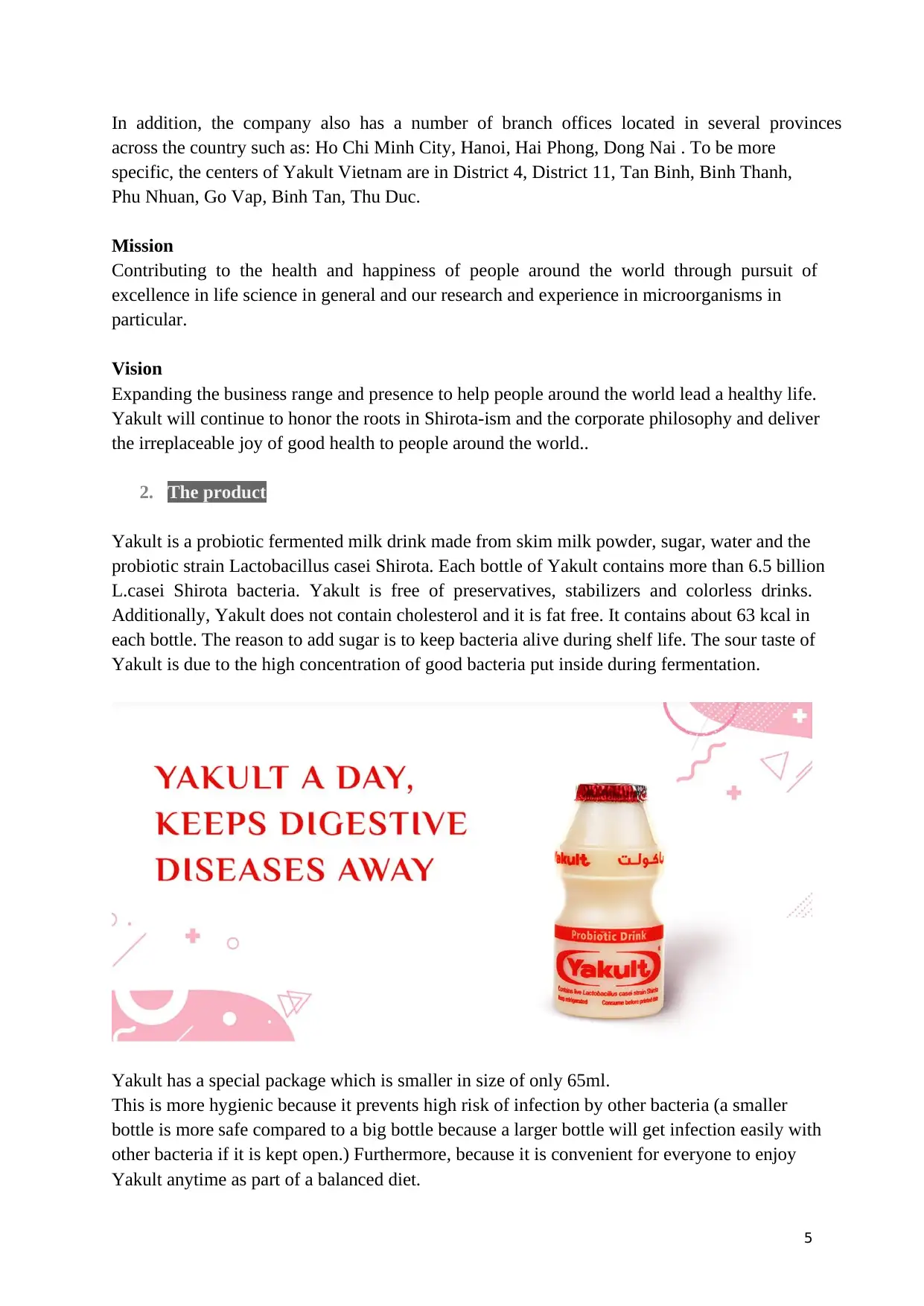
5
In addition, the company also has a number of branch offices located in several provinces
across the country such as: Ho Chi Minh City, Hanoi, Hai Phong, Dong Nai . To be more
specific, the centers of Yakult Vietnam are in District 4, District 11, Tan Binh, Binh Thanh,
Phu Nhuan, Go Vap, Binh Tan, Thu Duc.
Mission
Contributing to the health and happiness of people around the world through pursuit of
excellence in life science in general and our research and experience in microorganisms in
particular.
Vision
Expanding the business range and presence to help people around the world lead a healthy life.
Yakult will continue to honor the roots in Shirota-ism and the corporate philosophy and deliver
the irreplaceable joy of good health to people around the world..
2. The product
Yakult is a probiotic fermented milk drink made from skim milk powder, sugar, water and the
probiotic strain Lactobacillus casei Shirota. Each bottle of Yakult contains more than 6.5 billion
L.casei Shirota bacteria. Yakult is free of preservatives, stabilizers and colorless drinks.
Additionally, Yakult does not contain cholesterol and it is fat free. It contains about 63 kcal in
each bottle. The reason to add sugar is to keep bacteria alive during shelf life. The sour taste of
Yakult is due to the high concentration of good bacteria put inside during fermentation.
Yakult has a special package which is smaller in size of only 65ml.
This is more hygienic because it prevents high risk of infection by other bacteria (a smaller
bottle is more safe compared to a big bottle because a larger bottle will get infection easily with
other bacteria if it is kept open.) Furthermore, because it is convenient for everyone to enjoy
Yakult anytime as part of a balanced diet.
In addition, the company also has a number of branch offices located in several provinces
across the country such as: Ho Chi Minh City, Hanoi, Hai Phong, Dong Nai . To be more
specific, the centers of Yakult Vietnam are in District 4, District 11, Tan Binh, Binh Thanh,
Phu Nhuan, Go Vap, Binh Tan, Thu Duc.
Mission
Contributing to the health and happiness of people around the world through pursuit of
excellence in life science in general and our research and experience in microorganisms in
particular.
Vision
Expanding the business range and presence to help people around the world lead a healthy life.
Yakult will continue to honor the roots in Shirota-ism and the corporate philosophy and deliver
the irreplaceable joy of good health to people around the world..
2. The product
Yakult is a probiotic fermented milk drink made from skim milk powder, sugar, water and the
probiotic strain Lactobacillus casei Shirota. Each bottle of Yakult contains more than 6.5 billion
L.casei Shirota bacteria. Yakult is free of preservatives, stabilizers and colorless drinks.
Additionally, Yakult does not contain cholesterol and it is fat free. It contains about 63 kcal in
each bottle. The reason to add sugar is to keep bacteria alive during shelf life. The sour taste of
Yakult is due to the high concentration of good bacteria put inside during fermentation.
Yakult has a special package which is smaller in size of only 65ml.
This is more hygienic because it prevents high risk of infection by other bacteria (a smaller
bottle is more safe compared to a big bottle because a larger bottle will get infection easily with
other bacteria if it is kept open.) Furthermore, because it is convenient for everyone to enjoy
Yakult anytime as part of a balanced diet.

6
Basically, the Yakult recipe is not much different from other fermented yogurts, but the biggest
difference of the product is the probiotic L.casei Shirota. As we know, the body of an adult has
about 1 to 1.5 kg of bacteria in the intestinal tract, in which, if the body of a healthy person, the
number of beneficial bacteria will occupy a rate of 85%. These bacteria enter our bodies
through many different routes, but mainly through the mouth. In order to survive in the small
intestine, these beneficial bacteria must survive the impact of gastric juice, gastric juice of the
digestive system and the survival rate of beneficial bacteria is usually very low. L.casei Shirota
is the biggest difference of Yakult because this probiotic has a high survival rate when it reaches
our small intestine.
Yakult benefits
- Maintain the balance of intestinal microflora, increase beneficial bacteria and reduce
harmful bacteria.
- Reduce the formation of harmful substances, toxins and inhibit the formation of
substances causing intestinal necrosis.
- Regulating the immune system, preventing infectious diseases and cancer
3. The competitors
Direct competitors: probiotic fermented milk drink like Proby, Betagen
Indirect competitors: yogurt, whey
4. SWOT analysis
Strengths:
- High brand awareness (70%)
- Strong brand reputation with health benefits
Weaknesses:
- Limited flavor (only 1 sour)
- Storage Difficulty (low temperature)
Opportunities:
- Trend in health concerns
- Increase market penetration through convenience stores and supermarkets
Threats:
- Competitors provide many flavors, packaging, and promotions
- Lactobacillus is not unique and exclusive anymore
Basically, the Yakult recipe is not much different from other fermented yogurts, but the biggest
difference of the product is the probiotic L.casei Shirota. As we know, the body of an adult has
about 1 to 1.5 kg of bacteria in the intestinal tract, in which, if the body of a healthy person, the
number of beneficial bacteria will occupy a rate of 85%. These bacteria enter our bodies
through many different routes, but mainly through the mouth. In order to survive in the small
intestine, these beneficial bacteria must survive the impact of gastric juice, gastric juice of the
digestive system and the survival rate of beneficial bacteria is usually very low. L.casei Shirota
is the biggest difference of Yakult because this probiotic has a high survival rate when it reaches
our small intestine.
Yakult benefits
- Maintain the balance of intestinal microflora, increase beneficial bacteria and reduce
harmful bacteria.
- Reduce the formation of harmful substances, toxins and inhibit the formation of
substances causing intestinal necrosis.
- Regulating the immune system, preventing infectious diseases and cancer
3. The competitors
Direct competitors: probiotic fermented milk drink like Proby, Betagen
Indirect competitors: yogurt, whey
4. SWOT analysis
Strengths:
- High brand awareness (70%)
- Strong brand reputation with health benefits
Weaknesses:
- Limited flavor (only 1 sour)
- Storage Difficulty (low temperature)
Opportunities:
- Trend in health concerns
- Increase market penetration through convenience stores and supermarkets
Threats:
- Competitors provide many flavors, packaging, and promotions
- Lactobacillus is not unique and exclusive anymore
⊘ This is a preview!⊘
Do you want full access?
Subscribe today to unlock all pages.

Trusted by 1+ million students worldwide
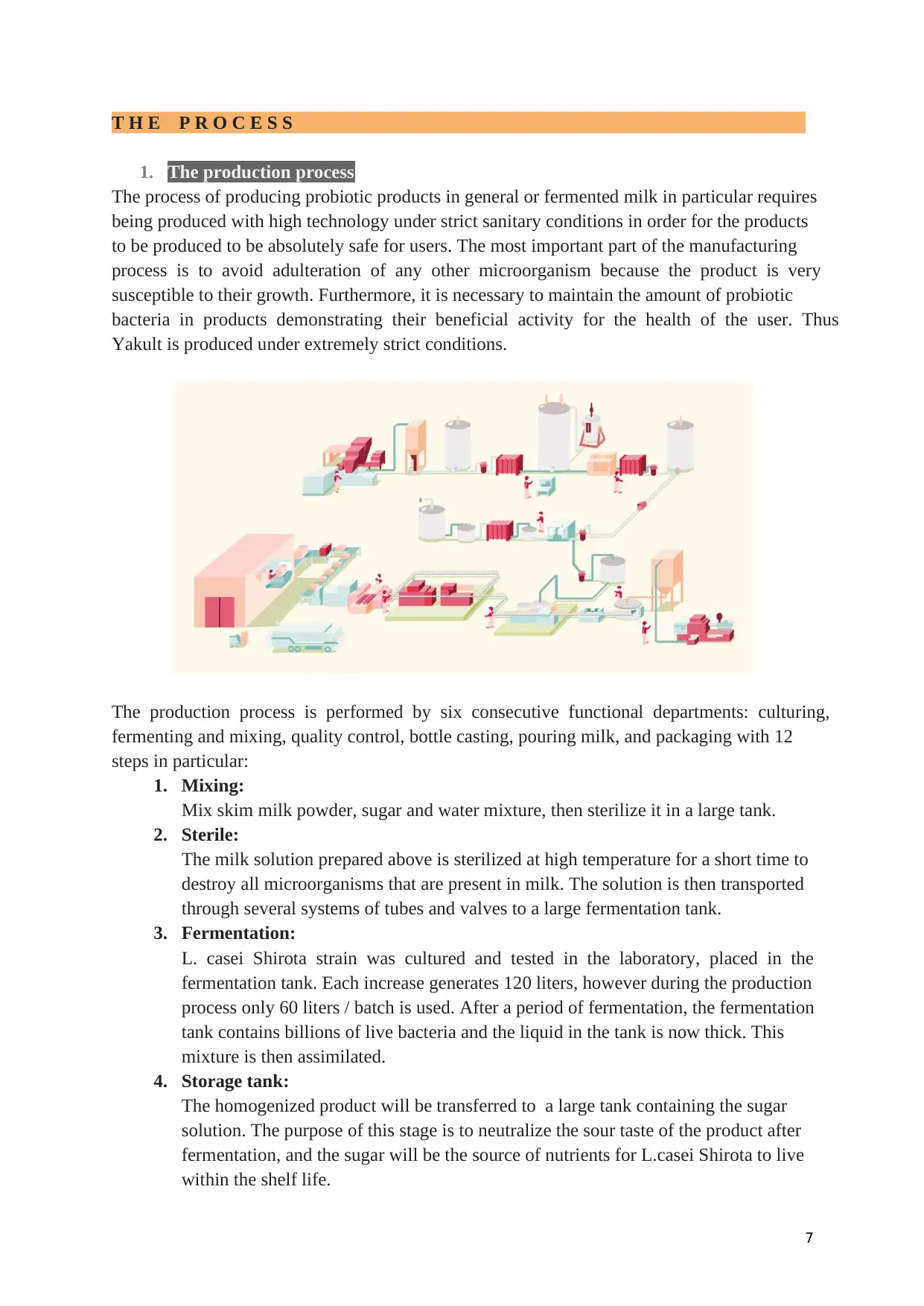
7
T H E P R O C E S S
1. The production process
The process of producing probiotic products in general or fermented milk in particular requires
being produced with high technology under strict sanitary conditions in order for the products
to be produced to be absolutely safe for users. The most important part of the manufacturing
process is to avoid adulteration of any other microorganism because the product is very
susceptible to their growth. Furthermore, it is necessary to maintain the amount of probiotic
bacteria in products demonstrating their beneficial activity for the health of the user. Thus
Yakult is produced under extremely strict conditions.
The production process is performed by six consecutive functional departments: culturing,
fermenting and mixing, quality control, bottle casting, pouring milk, and packaging with 12
steps in particular:
1. Mixing:
Mix skim milk powder, sugar and water mixture, then sterilize it in a large tank.
2. Sterile:
The milk solution prepared above is sterilized at high temperature for a short time to
destroy all microorganisms that are present in milk. The solution is then transported
through several systems of tubes and valves to a large fermentation tank.
3. Fermentation:
L. casei Shirota strain was cultured and tested in the laboratory, placed in the
fermentation tank. Each increase generates 120 liters, however during the production
process only 60 liters / batch is used. After a period of fermentation, the fermentation
tank contains billions of live bacteria and the liquid in the tank is now thick. This
mixture is then assimilated.
4. Storage tank:
The homogenized product will be transferred to a large tank containing the sugar
solution. The purpose of this stage is to neutralize the sour taste of the product after
fermentation, and the sugar will be the source of nutrients for L.casei Shirota to live
within the shelf life.
T H E P R O C E S S
1. The production process
The process of producing probiotic products in general or fermented milk in particular requires
being produced with high technology under strict sanitary conditions in order for the products
to be produced to be absolutely safe for users. The most important part of the manufacturing
process is to avoid adulteration of any other microorganism because the product is very
susceptible to their growth. Furthermore, it is necessary to maintain the amount of probiotic
bacteria in products demonstrating their beneficial activity for the health of the user. Thus
Yakult is produced under extremely strict conditions.
The production process is performed by six consecutive functional departments: culturing,
fermenting and mixing, quality control, bottle casting, pouring milk, and packaging with 12
steps in particular:
1. Mixing:
Mix skim milk powder, sugar and water mixture, then sterilize it in a large tank.
2. Sterile:
The milk solution prepared above is sterilized at high temperature for a short time to
destroy all microorganisms that are present in milk. The solution is then transported
through several systems of tubes and valves to a large fermentation tank.
3. Fermentation:
L. casei Shirota strain was cultured and tested in the laboratory, placed in the
fermentation tank. Each increase generates 120 liters, however during the production
process only 60 liters / batch is used. After a period of fermentation, the fermentation
tank contains billions of live bacteria and the liquid in the tank is now thick. This
mixture is then assimilated.
4. Storage tank:
The homogenized product will be transferred to a large tank containing the sugar
solution. The purpose of this stage is to neutralize the sour taste of the product after
fermentation, and the sugar will be the source of nutrients for L.casei Shirota to live
within the shelf life.
Paraphrase This Document
Need a fresh take? Get an instant paraphrase of this document with our AI Paraphraser
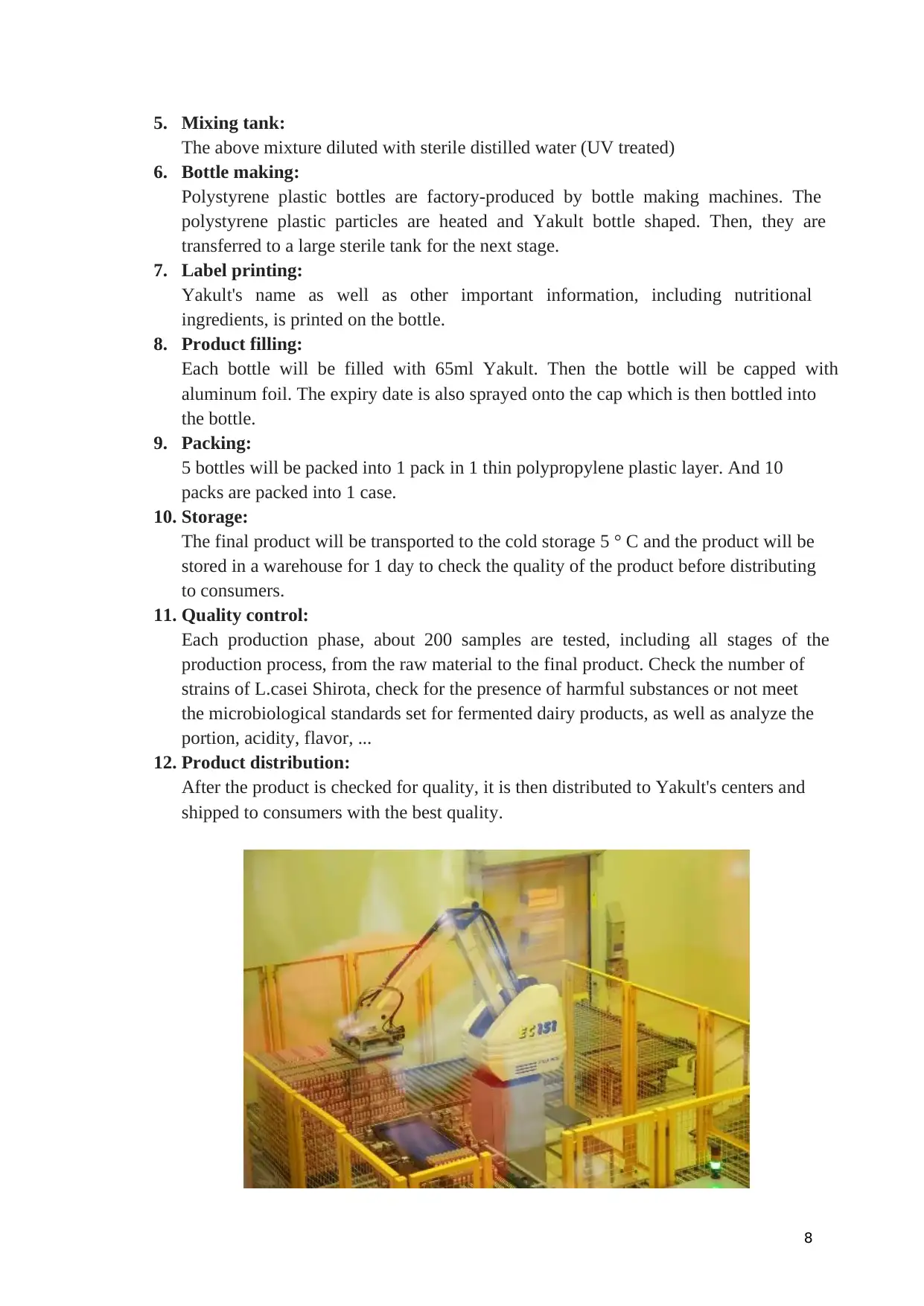
8
5. Mixing tank:
The above mixture diluted with sterile distilled water (UV treated)
6. Bottle making:
Polystyrene plastic bottles are factory-produced by bottle making machines. The
polystyrene plastic particles are heated and Yakult bottle shaped. Then, they are
transferred to a large sterile tank for the next stage.
7. Label printing:
Yakult's name as well as other important information, including nutritional
ingredients, is printed on the bottle.
8. Product filling:
Each bottle will be filled with 65ml Yakult. Then the bottle will be capped with
aluminum foil. The expiry date is also sprayed onto the cap which is then bottled into
the bottle.
9. Packing:
5 bottles will be packed into 1 pack in 1 thin polypropylene plastic layer. And 10
packs are packed into 1 case.
10. Storage:
The final product will be transported to the cold storage 5 ° C and the product will be
stored in a warehouse for 1 day to check the quality of the product before distributing
to consumers.
11. Quality control:
Each production phase, about 200 samples are tested, including all stages of the
production process, from the raw material to the final product. Check the number of
strains of L.casei Shirota, check for the presence of harmful substances or not meet
the microbiological standards set for fermented dairy products, as well as analyze the
portion, acidity, flavor, ...
12. Product distribution:
After the product is checked for quality, it is then distributed to Yakult's centers and
shipped to consumers with the best quality.
5. Mixing tank:
The above mixture diluted with sterile distilled water (UV treated)
6. Bottle making:
Polystyrene plastic bottles are factory-produced by bottle making machines. The
polystyrene plastic particles are heated and Yakult bottle shaped. Then, they are
transferred to a large sterile tank for the next stage.
7. Label printing:
Yakult's name as well as other important information, including nutritional
ingredients, is printed on the bottle.
8. Product filling:
Each bottle will be filled with 65ml Yakult. Then the bottle will be capped with
aluminum foil. The expiry date is also sprayed onto the cap which is then bottled into
the bottle.
9. Packing:
5 bottles will be packed into 1 pack in 1 thin polypropylene plastic layer. And 10
packs are packed into 1 case.
10. Storage:
The final product will be transported to the cold storage 5 ° C and the product will be
stored in a warehouse for 1 day to check the quality of the product before distributing
to consumers.
11. Quality control:
Each production phase, about 200 samples are tested, including all stages of the
production process, from the raw material to the final product. Check the number of
strains of L.casei Shirota, check for the presence of harmful substances or not meet
the microbiological standards set for fermented dairy products, as well as analyze the
portion, acidity, flavor, ...
12. Product distribution:
After the product is checked for quality, it is then distributed to Yakult's centers and
shipped to consumers with the best quality.
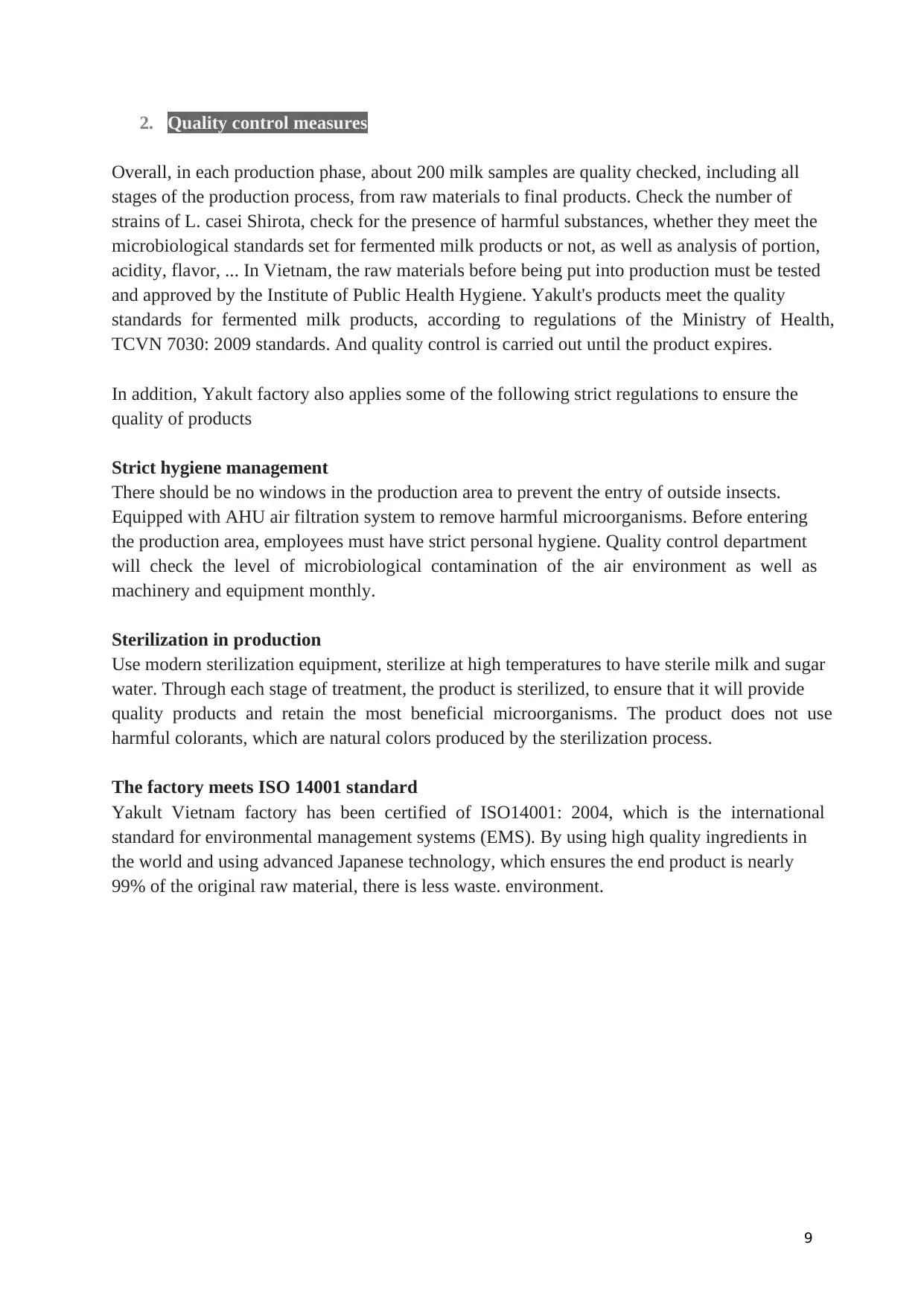
9
2. Quality control measures
Overall, in each production phase, about 200 milk samples are quality checked, including all
stages of the production process, from raw materials to final products. Check the number of
strains of L. casei Shirota, check for the presence of harmful substances, whether they meet the
microbiological standards set for fermented milk products or not, as well as analysis of portion,
acidity, flavor, ... In Vietnam, the raw materials before being put into production must be tested
and approved by the Institute of Public Health Hygiene. Yakult's products meet the quality
standards for fermented milk products, according to regulations of the Ministry of Health,
TCVN 7030: 2009 standards. And quality control is carried out until the product expires.
In addition, Yakult factory also applies some of the following strict regulations to ensure the
quality of products
Strict hygiene management
There should be no windows in the production area to prevent the entry of outside insects.
Equipped with AHU air filtration system to remove harmful microorganisms. Before entering
the production area, employees must have strict personal hygiene. Quality control department
will check the level of microbiological contamination of the air environment as well as
machinery and equipment monthly.
Sterilization in production
Use modern sterilization equipment, sterilize at high temperatures to have sterile milk and sugar
water. Through each stage of treatment, the product is sterilized, to ensure that it will provide
quality products and retain the most beneficial microorganisms. The product does not use
harmful colorants, which are natural colors produced by the sterilization process.
The factory meets ISO 14001 standard
Yakult Vietnam factory has been certified of ISO14001: 2004, which is the international
standard for environmental management systems (EMS). By using high quality ingredients in
the world and using advanced Japanese technology, which ensures the end product is nearly
99% of the original raw material, there is less waste. environment.
2. Quality control measures
Overall, in each production phase, about 200 milk samples are quality checked, including all
stages of the production process, from raw materials to final products. Check the number of
strains of L. casei Shirota, check for the presence of harmful substances, whether they meet the
microbiological standards set for fermented milk products or not, as well as analysis of portion,
acidity, flavor, ... In Vietnam, the raw materials before being put into production must be tested
and approved by the Institute of Public Health Hygiene. Yakult's products meet the quality
standards for fermented milk products, according to regulations of the Ministry of Health,
TCVN 7030: 2009 standards. And quality control is carried out until the product expires.
In addition, Yakult factory also applies some of the following strict regulations to ensure the
quality of products
Strict hygiene management
There should be no windows in the production area to prevent the entry of outside insects.
Equipped with AHU air filtration system to remove harmful microorganisms. Before entering
the production area, employees must have strict personal hygiene. Quality control department
will check the level of microbiological contamination of the air environment as well as
machinery and equipment monthly.
Sterilization in production
Use modern sterilization equipment, sterilize at high temperatures to have sterile milk and sugar
water. Through each stage of treatment, the product is sterilized, to ensure that it will provide
quality products and retain the most beneficial microorganisms. The product does not use
harmful colorants, which are natural colors produced by the sterilization process.
The factory meets ISO 14001 standard
Yakult Vietnam factory has been certified of ISO14001: 2004, which is the international
standard for environmental management systems (EMS). By using high quality ingredients in
the world and using advanced Japanese technology, which ensures the end product is nearly
99% of the original raw material, there is less waste. environment.
⊘ This is a preview!⊘
Do you want full access?
Subscribe today to unlock all pages.

Trusted by 1+ million students worldwide
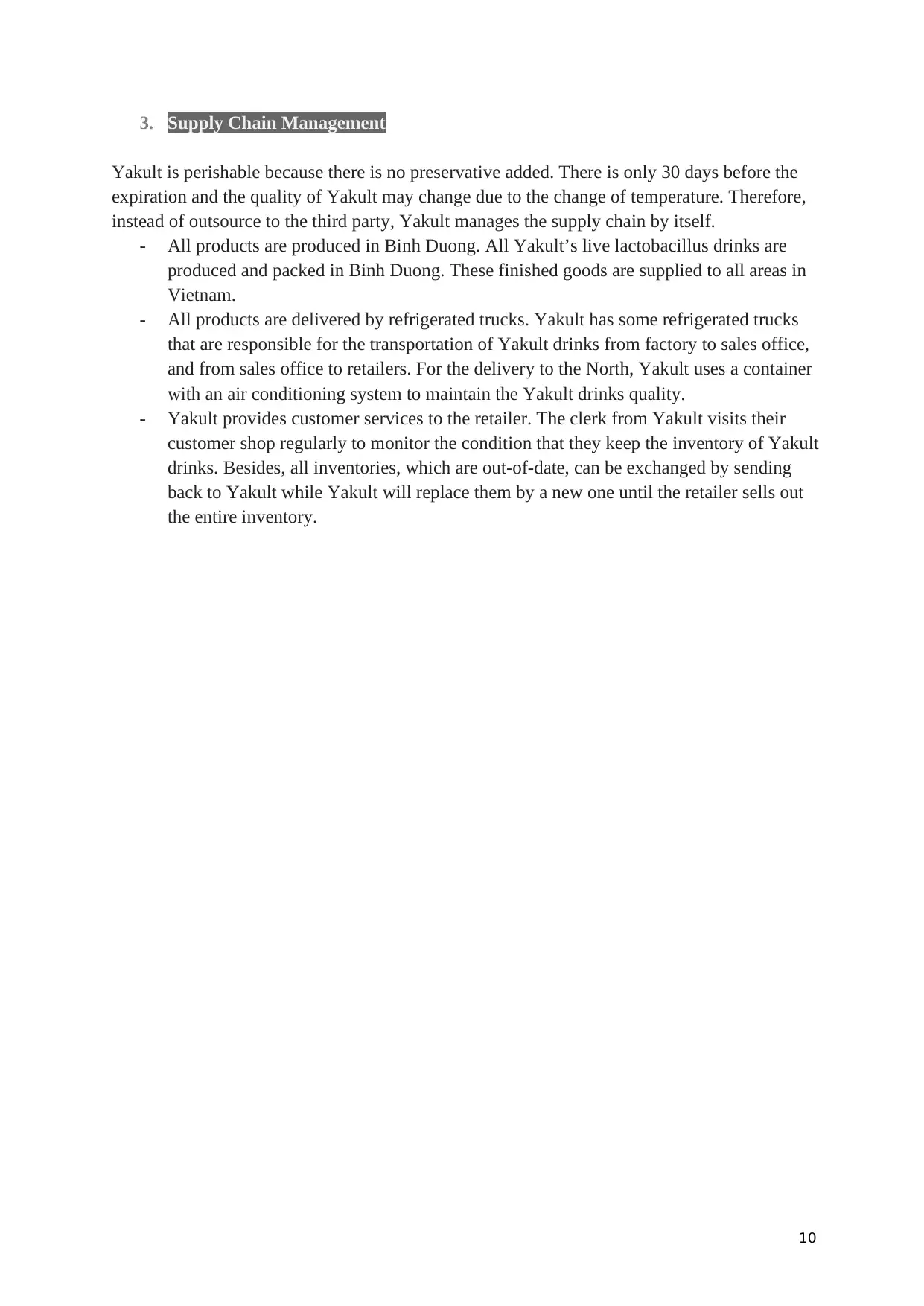
10
3. Supply Chain Management
Yakult is perishable because there is no preservative added. There is only 30 days before the
expiration and the quality of Yakult may change due to the change of temperature. Therefore,
instead of outsource to the third party, Yakult manages the supply chain by itself.
- All products are produced in Binh Duong. All Yakult’s live lactobacillus drinks are
produced and packed in Binh Duong. These finished goods are supplied to all areas in
Vietnam.
- All products are delivered by refrigerated trucks. Yakult has some refrigerated trucks
that are responsible for the transportation of Yakult drinks from factory to sales office,
and from sales office to retailers. For the delivery to the North, Yakult uses a container
with an air conditioning system to maintain the Yakult drinks quality.
- Yakult provides customer services to the retailer. The clerk from Yakult visits their
customer shop regularly to monitor the condition that they keep the inventory of Yakult
drinks. Besides, all inventories, which are out-of-date, can be exchanged by sending
back to Yakult while Yakult will replace them by a new one until the retailer sells out
the entire inventory.
3. Supply Chain Management
Yakult is perishable because there is no preservative added. There is only 30 days before the
expiration and the quality of Yakult may change due to the change of temperature. Therefore,
instead of outsource to the third party, Yakult manages the supply chain by itself.
- All products are produced in Binh Duong. All Yakult’s live lactobacillus drinks are
produced and packed in Binh Duong. These finished goods are supplied to all areas in
Vietnam.
- All products are delivered by refrigerated trucks. Yakult has some refrigerated trucks
that are responsible for the transportation of Yakult drinks from factory to sales office,
and from sales office to retailers. For the delivery to the North, Yakult uses a container
with an air conditioning system to maintain the Yakult drinks quality.
- Yakult provides customer services to the retailer. The clerk from Yakult visits their
customer shop regularly to monitor the condition that they keep the inventory of Yakult
drinks. Besides, all inventories, which are out-of-date, can be exchanged by sending
back to Yakult while Yakult will replace them by a new one until the retailer sells out
the entire inventory.
Paraphrase This Document
Need a fresh take? Get an instant paraphrase of this document with our AI Paraphraser
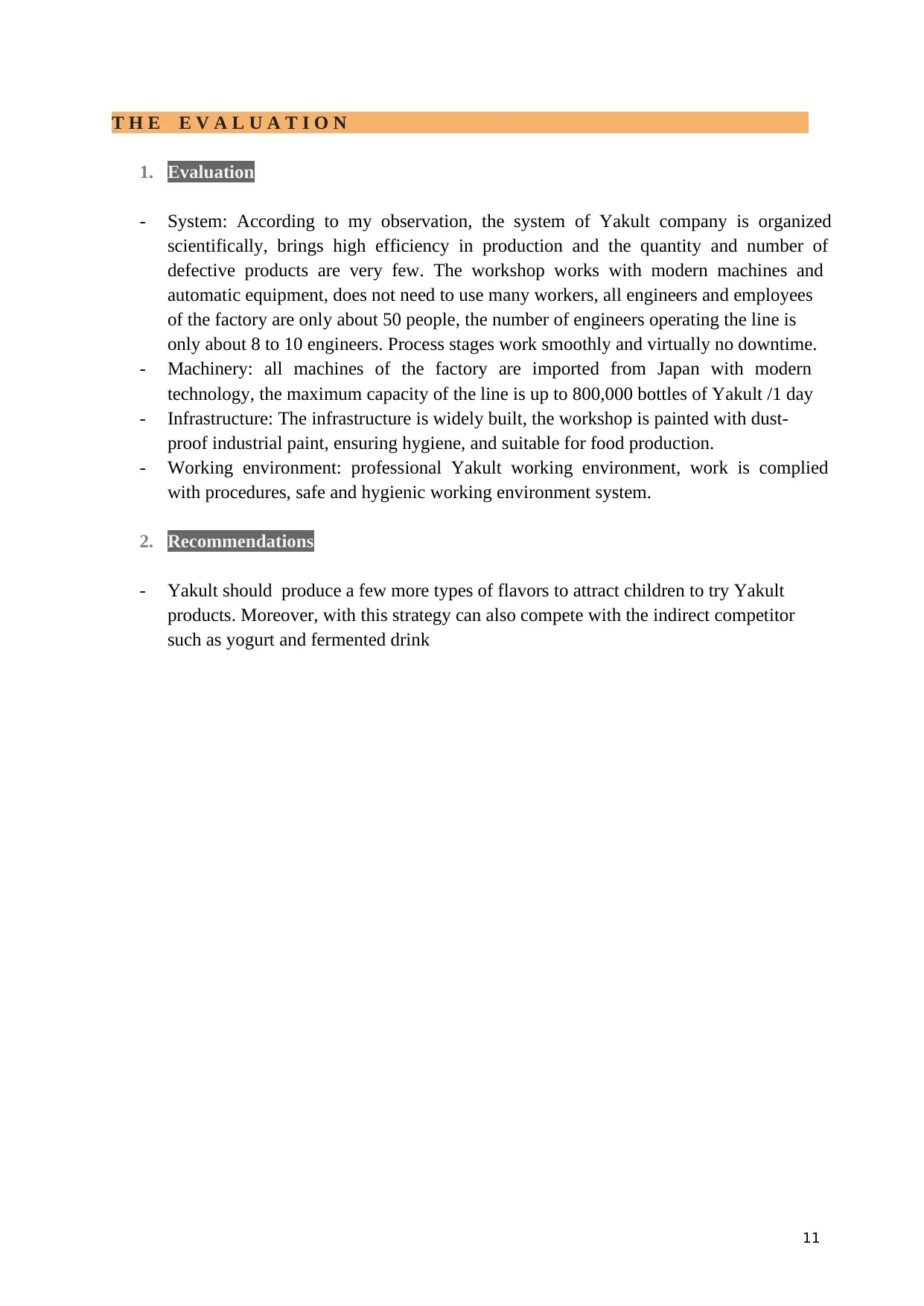
11
T H E E V A L U A T I O N
1. Evaluation
- System: According to my observation, the system of Yakult company is organized
scientifically, brings high efficiency in production and the quantity and number of
defective products are very few. The workshop works with modern machines and
automatic equipment, does not need to use many workers, all engineers and employees
of the factory are only about 50 people, the number of engineers operating the line is
only about 8 to 10 engineers. Process stages work smoothly and virtually no downtime.
- Machinery: all machines of the factory are imported from Japan with modern
technology, the maximum capacity of the line is up to 800,000 bottles of Yakult /1 day
- Infrastructure: The infrastructure is widely built, the workshop is painted with dust-
proof industrial paint, ensuring hygiene, and suitable for food production.
- Working environment: professional Yakult working environment, work is complied
with procedures, safe and hygienic working environment system.
2. Recommendations
- Yakult should produce a few more types of flavors to attract children to try Yakult
products. Moreover, with this strategy can also compete with the indirect competitor
such as yogurt and fermented drink
T H E E V A L U A T I O N
1. Evaluation
- System: According to my observation, the system of Yakult company is organized
scientifically, brings high efficiency in production and the quantity and number of
defective products are very few. The workshop works with modern machines and
automatic equipment, does not need to use many workers, all engineers and employees
of the factory are only about 50 people, the number of engineers operating the line is
only about 8 to 10 engineers. Process stages work smoothly and virtually no downtime.
- Machinery: all machines of the factory are imported from Japan with modern
technology, the maximum capacity of the line is up to 800,000 bottles of Yakult /1 day
- Infrastructure: The infrastructure is widely built, the workshop is painted with dust-
proof industrial paint, ensuring hygiene, and suitable for food production.
- Working environment: professional Yakult working environment, work is complied
with procedures, safe and hygienic working environment system.
2. Recommendations
- Yakult should produce a few more types of flavors to attract children to try Yakult
products. Moreover, with this strategy can also compete with the indirect competitor
such as yogurt and fermented drink
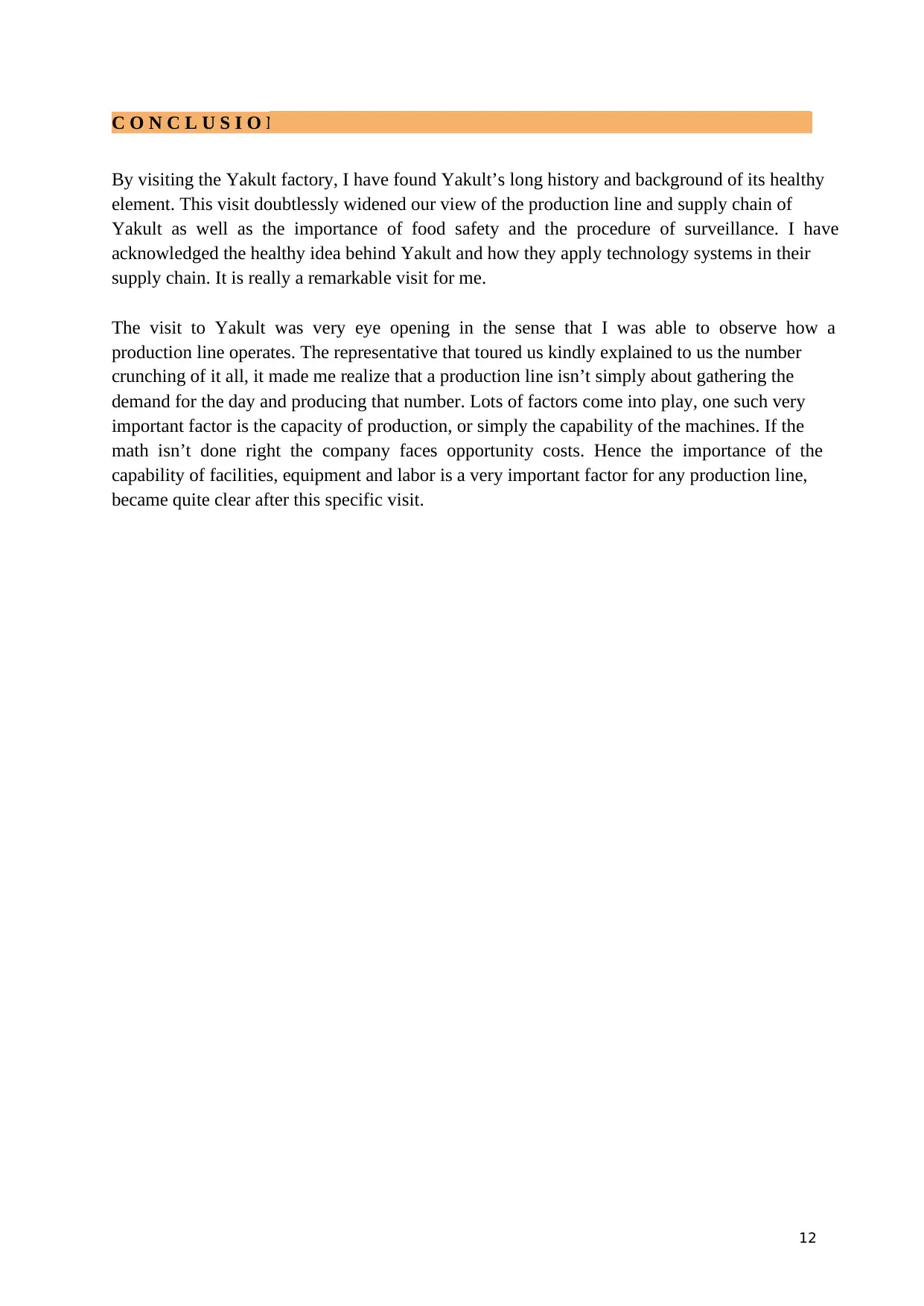
12
C O N C L U S I O N
By visiting the Yakult factory, I have found Yakult’s long history and background of its healthy
element. This visit doubtlessly widened our view of the production line and supply chain of
Yakult as well as the importance of food safety and the procedure of surveillance. I have
acknowledged the healthy idea behind Yakult and how they apply technology systems in their
supply chain. It is really a remarkable visit for me.
The visit to Yakult was very eye opening in the sense that I was able to observe how a
production line operates. The representative that toured us kindly explained to us the number
crunching of it all, it made me realize that a production line isn’t simply about gathering the
demand for the day and producing that number. Lots of factors come into play, one such very
important factor is the capacity of production, or simply the capability of the machines. If the
math isn’t done right the company faces opportunity costs. Hence the importance of the
capability of facilities, equipment and labor is a very important factor for any production line,
became quite clear after this specific visit.
C O N C L U S I O N
By visiting the Yakult factory, I have found Yakult’s long history and background of its healthy
element. This visit doubtlessly widened our view of the production line and supply chain of
Yakult as well as the importance of food safety and the procedure of surveillance. I have
acknowledged the healthy idea behind Yakult and how they apply technology systems in their
supply chain. It is really a remarkable visit for me.
The visit to Yakult was very eye opening in the sense that I was able to observe how a
production line operates. The representative that toured us kindly explained to us the number
crunching of it all, it made me realize that a production line isn’t simply about gathering the
demand for the day and producing that number. Lots of factors come into play, one such very
important factor is the capacity of production, or simply the capability of the machines. If the
math isn’t done right the company faces opportunity costs. Hence the importance of the
capability of facilities, equipment and labor is a very important factor for any production line,
became quite clear after this specific visit.
⊘ This is a preview!⊘
Do you want full access?
Subscribe today to unlock all pages.

Trusted by 1+ million students worldwide
1 out of 13
Related Documents
Your All-in-One AI-Powered Toolkit for Academic Success.
+13062052269
info@desklib.com
Available 24*7 on WhatsApp / Email
![[object Object]](/_next/static/media/star-bottom.7253800d.svg)
Unlock your academic potential
Copyright © 2020–2025 A2Z Services. All Rights Reserved. Developed and managed by ZUCOL.





